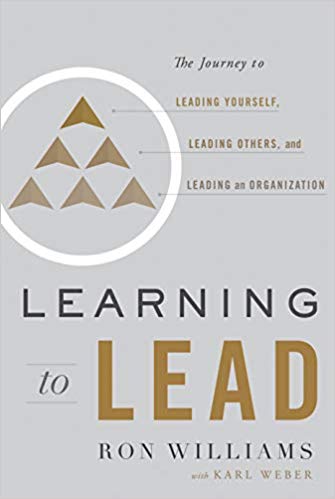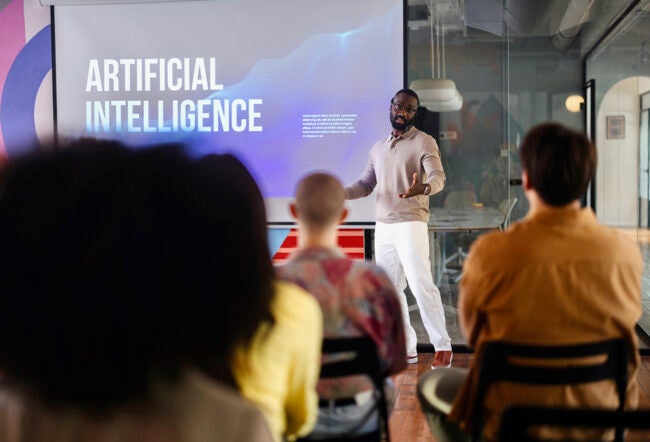 As a longtime business executive, Ron Williams is often asked for advice on management issues. He likes to keep his answers clear and simple. One of his favorite mantras is, “Don’t get stuck in paralysis by analysis.” He also tells young people not to map every step of their careers because, like him, they never know where they may end up. Williams grew up in Chicago’s South Side, where he used to wash cars, and became one of the few African-Americans to lead a Fortune 500 company, serving as chairman and chief executive officer of Aetna. He’s on the board at American Express, Boeing and Johnson & Johnson, and also runs his consultancy, RW2 Enterprises. Williams shares his life lessons and experiences in a new book, Learning to Lead: The Journey to Leading Yourself, Leading Others, and Leading an Organization. He joined the Knowledge at Wharton radio show on Sirius XM to talk about why the best leaders keep an open mind and never stop learning from the people around them. (Listen to the podcast at the top of this page).
As a longtime business executive, Ron Williams is often asked for advice on management issues. He likes to keep his answers clear and simple. One of his favorite mantras is, “Don’t get stuck in paralysis by analysis.” He also tells young people not to map every step of their careers because, like him, they never know where they may end up. Williams grew up in Chicago’s South Side, where he used to wash cars, and became one of the few African-Americans to lead a Fortune 500 company, serving as chairman and chief executive officer of Aetna. He’s on the board at American Express, Boeing and Johnson & Johnson, and also runs his consultancy, RW2 Enterprises. Williams shares his life lessons and experiences in a new book, Learning to Lead: The Journey to Leading Yourself, Leading Others, and Leading an Organization. He joined the Knowledge at Wharton radio show on Sirius XM to talk about why the best leaders keep an open mind and never stop learning from the people around them. (Listen to the podcast at the top of this page).
An edited transcript of the conversation follows.
Knowledge at Wharton: I read that part of the reason why you wrote this book was because you have often been asked to talk about your upbringing and career, going from Chicago to CEO.
Ron Williams: That’s correct. I get quite a few phone calls from CEOs who are going through transformational change or confronting particular problems. And I’ve gotten a lot of phone calls from people who were completing their MBA programs, who were mid-career, who were aspiring leaders, trying to figure out how do they develop, what do they need to do in order to get to the C-suite? Based on that, I determined that it would be helpful to have a practitioner’s point of view. The book’s about my experience, but it’s also about a collection of other CEOs, including women CEOs, who have risen to the top from fairly modest backgrounds.
Knowledge at Wharton: How did you develop your leadership skills and style over the years?
Williams: There are several things that I always recommend. One is that you have to adopt a particular leadership style and approach. The approach I describe is values-based high performance. You treat people with respect and learn how you can make certain that people are achieving the right goals, doing it the right way, getting the counseling assistance that they need. Thinking consciously about your performance approach is really important.
Knowledge at Wharton: Can you talk about mentorship and feedback, which are two topics in the book?
“Many believe leaders are born with some innate charisma, and certainly there are leaders who do have that capability. But the vast majority of leadership is learned.”
Williams: Mentorship is extremely important. People often think is that there’s only one way to have a mentor. In a lot of ways, you have official mentors and you have unofficial mentors. You can learn as much about what not to do as you can about what to do. When you have an interest in a professional who has done well, who is exhibiting the kind of leadership attributes that you think could be helpful, working to establish that relationship is extremely important. But you can learn from everyone that you come into contact with, if you have an open mind.
Knowledge at Wharton: When do you think the idea of being a leader starts to formulate in a person’s mind?
Williams: It’s a journey, it’s not an event. It’s not a process. Many believe that leaders are born with some innate charisma, and certainly there are leaders who do have that capability. But the vast majority of leadership is learned. It’s individuals who have a high tolerance of failure, who have an ability to get up and to try to demonstrate leadership and participate in activities where they learn the lessons of leadership from others.
Knowledge at Wharton: You say that values are an important component to leadership, so does the size of the company matter? If you’re following what you believe to be good values and core competencies, can you have the same success as a leader in a small business as you can in a Fortune 500 firm?
Williams: That’s true. One thing I learned along the way is that, as a CEO or the CFO, you are very excited about the financial results of the business. But most people who work in a business want to be part of a clear and elevating goal. They want to make the world a better place. One of the obligations of a leader is to connect the business activity to things that make the world a much better place.
Knowledge at Wharton: What are the unique sets of challenges to managing a startup or smaller business?
Williams: One is the rate at which people are hired. You end up with the person you hired six months ago training the person you hired three months ago, who’s training the person you hired a month ago, who’s training the person you hired yesterday. It can lead to a dilution of both the company culture and lack of clarity around the strategy and what the founders really want to accomplish. Maintaining that over the rapid pace of change and staying connected to the customer base in that period does require somewhat different leadership skills, because it’s much more about finding your place in the market than an organization that is very large, which has a different set of challenges.
When you’re building it out and rapidly hiring, it’s extremely important that those new employees really understand the strategy, the values and the culture of the company to avoid significant problems. One of the things that companies often don’t fully appreciate is that the culture and values are the curbs on the side of the road that keep the company out of trouble. The more you emphasize those, the taller those curbs get on the roadway. And they provide a lot of insulation against challenges and troubles.
“It’s extremely important to being a good leader that you be self-aware.”
Knowledge at Wharton: How important is corporate culture?
Williams: There’s an expression that “culture eats strategy.” What that means is that you can have the strategy, but you must have a culture that supports the strategy. Most importantly, you must have a human capital strategy, meaning the right people in the right jobs. Culture is not what the leadership says it is; culture is what people actually experience every day. The objective of the leader is to align what they believe the culture should be with what employees on the front line say the culture actually is.
Knowledge at Wharton: But shouldn’t the culture filter down from the C-suite to the mid-level managers to the employees so there’s no ambiguity?
Williams: That comes to the communication issue, because you’re absolutely right. Many of the messages that start at the top don’t make it through the middle layer of the organization, so there has to be very structured and disciplined communication, and the organization has to work very hard. One of the things I say is that when the senior leadership team has described the culture and the values and the messages so much they could scream, they probably have reached about a third of the people.
Knowledge at Wharton: One of your really strong beliefs is being able to lead yourself. What did you learn about yourself as you were coming up through your career that helped you become better?
Williams: It’s extremely important to being a good leader that you be self-aware. In being self-aware, you have to solicit feedback from others. People have to be comfortable giving you feedback. One of the things I would always do with my direct reports is to end every one-on-one session with the question: “What can I do better? What can I do better to help you? What can I do better to help the organization?” It required people to have a meaningful discussion about that. Sooner or later, people figure out that it’s a real opportunity for input. You have to be prepared to have that kind of input and be self-aware about not just your intent in interacting with people, but also your impact in interacting with people.
Knowledge at Wharton: How has the digital era changed leadership?
Williams: One way is response time. In the digital era, you have to be prepared to respond instantly to multi-stakeholder issues that come up. Half of the responses want you to go left, the other half want you to go right. You have to figure out, as the leader and the spokesperson of the company, what you need to do in order to speak to the issue. It doesn’t mean always doing what everyone wants you to do, but it means articulating what you believe you should do and why the other point of view is not what you believe the organization should do. Communication is just absolutely essential.
“Culture is not what the leadership says it is; culture is what people actually experience every day.”
Knowledge at Wharton: Let’s talk about the mid-level manager who has to respond to the different executives above him or her. That manager may be getting mixed messages on which direction to go.
Williams: It’s quite common today in the matrix environment where a person reports to one boss for part of a project and for another boss for another aspect of what they do. You end up with two managers who may have different points of view, and that’s where the values and the culture of the organization become really critical. Because you want to be certain that if there are two or more executives involved, that all decisions, all actions, are consistent with the values of the company as they’ve been articulated.
Knowledge at Wharton: In education now, there is greater emphasis on science, technology, engineering and math (STEM), and learning to be problem-solvers. We’re not grounded in philosophy. Do you think it’s important to learn philosophy and the social sciences as underpinnings to leadership?
Williams: It is extremely important to have a broad perspective, to have a functional technical discipline but also to understand history, philosophy and human interaction. Because no matter what domain you’re in, you’re going to work with teams of people. One of the fundamental points I always stress is that your consideration for the individuals involved has to be higher than your focus on the task to be done.
People often think that means lowering consideration for the task. That’s the wrong answer. You have to be task focused. You have to be driven to produce the software, solve the engineering problem, get the details done. You solve that by raising your consideration for the people involved so that it is higher than that task focus. And that kind of broad background is helpful. You don’t have to get it through formal education in college or university. It’s through reading; it can be through self-study, or it can be through interaction with other people and mentors.
Knowledge at Wharton: There is a chapter titled “Make Your Enemies Disappear, Assume Positive Intent.” That approach shouldn’t be only with other executives, but it also should be with other companies to help break down some of those walls that may be there. Do you agree?
Williams: That’s extremely important. This whole notion of assuming positive intent assumes that each person is pursuing a course that makes sense from their point of view. If you have the conversation, and you try to understand their perspective and point of view, hopefully you can come to a win/win. Now, it’s clear also in life that there are people who behave badly, and the object is not to be a pushover. But there are other books written on how to deal with jerks, which is not what my book’s about.
My book’s about when you’re in a business negotiation or a discussion, or someone says something that might be initially somewhat offensive, if you assume positive intent, you’re able to determine over time whether this was just a casual comment or something that they hadn’t thought about, or whether the person really is a jerk and you have to go to a different place.
Knowledge at Wharton: Drawing on your time at Aetna, you wrote about some of the issues in the health care sector. I think that is as challenging as anything we have out there right now.
Williams: It certainly is. As you know, it’s a huge part of the economy. It’s almost 20% of our GDP. It’s growing at a rate that’s a multiple of the CPI growth that we experience. So, there’s a huge opportunity to create more value in health care. As we tackle the problems of access and making certain that everyone ultimately has access to health care, the Affordable Care Act extended access to individuals who really were what I’ll call the working poor. They made too much for certain government programs of assistance, but often, they didn’t work in companies or have access to health insurance. That was a very important population.
But we still have a lot of work to do to make certain that people have access to coverage that everyone can afford. The answer is really continuing to digitize, continuing to use analytics, eliminating waste in the health care system and helping those individuals who have chronic conditions do a better job of managing their conditions, improving their quality of their life and decreasing the costs of care for them.
“One of the fundamental points I always stress is that your consideration for the individuals involved has to be higher than your focus on the task to be done.”
No one would build a system that works the way our health care does in the U.S. because of the way it’s evolved. But changes to the system have to take into account the cultural context of the U.S. What works in the U.K., what works in France, what works in other countries, can’t be imported into the U.S. We’re a different country. We have a different culture. We have different traditions. We need market-based solutions that do, in fact, improve the affordability of the system.
Knowledge at Wharton: Will the concept of leadership evolve as we go forward or will the core principles remain?
Williams: Leadership will continue to evolve. In my book, I talk about leading yourself, leading others and leading organizations. What’s evolved is that, as the leader of the organization, one of the single most important things is really leading yourself. Because you have more degrees of opportunity to make mistakes, more degrees of freedom to make bad judgments. So, this sense of self-awareness and effectively leading yourself as a leader is important, and also changing. We’re experiencing things like the #MeToo movement, which has been extremely important.
Knowledge at Wharton: How important is that self-awareness in leading teams?
Williams: My experience has been that teams are much better at identifying solutions and options and generating alternatives. Making decisions is a leadership issue. Like in Aetna, for example, if it was a clinical decision, our chief medical officer made the decision. If it was an information technology or digitization, that team made the decision. But you really need to have a person who listens to all the input, hears the pros, hears the cons, gathers the relevant facts — not all the facts, or you can chase them down a rabbit hole and waste a lot of time — and then makes a decision. Think about the team as advisory and the leader as the decision-maker.



